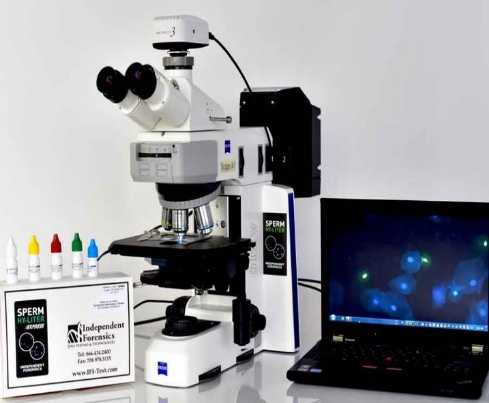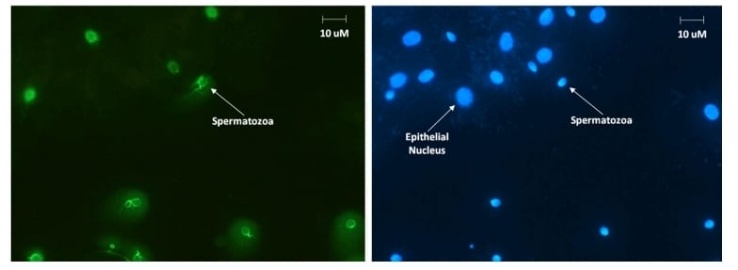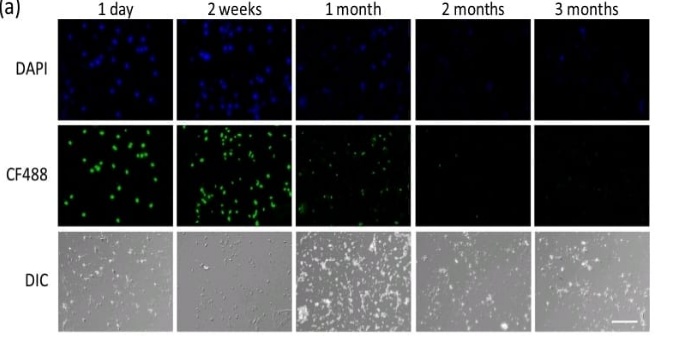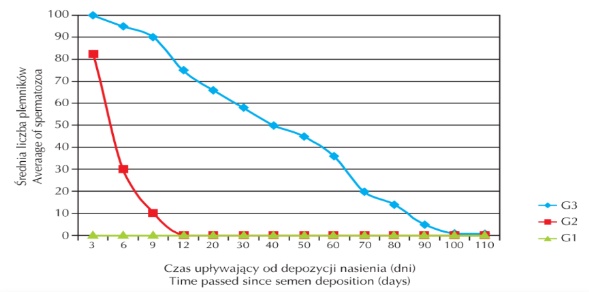Keywords:
SPERM HY-LITERTM
Express, spermatozoa, sexual assault, fluorescence microscopes, CF-488A, mouse
monoclonal antibody, forensic investigations.
The identification of spermatozoa is
the most significant test for confirming sexual assault cases in the forensic
domain. There are a variety of staining methods that can detect spermatozoa
using either light or fluorescence microscopes. SPERM HY-LITER Express is one
of the forensic stains used in detecting spermatozoa in postcoital samples. The
approach provides several benefits, such as sensitivity, specificity,
longevity, and favoritism. Nevertheless, it has limitations that highlight some
of its flaws.

SPERM
HY-LITERTM Express kits
SPERM
HY-LITERTM Express kits identify human sperm using a fluorescently tagged
antibody. Unlike other approaches that rely on protein markers in the seminal
fluid, the test microscope uses a CF-488A-conjugated mouse monoclonal antibody
specific to human sperm for analyzing sexual assault evidence. The kit includes
a reagent unique to human sperm and a fluorescent dye that stains all cell
nuclei in the sample (4',6-diamidino-2-phenylindole, DAPI). It is a systematic
and direct approach for processing samples using specific solutions to attach,
prepare, obstruct, and color microscopic evidence to identify human sperm.
Human sperm heads can be visualized using fluorescein or Alexa 488-compatible
filters and can be scanned at a final magnification of 100x, 200x, or 400x at
the operator's discretion. Fluorescent nuclei's vision is not required for sperm detection,
although it is beneficial for both manual and automated sperm analysis.

Microscopic analysis of SPERM
HY-LITE TM samples
The SPERM HY-LITE TM Express kit provides precise identification of human sperm in difficult conditions, delivering vital information for forensic investigations. The processing and fluorescent detection sample of human sperm can be seamlessly integrated into existing forensic laboratory protocols for DNA analysis, before performing STR testing. Its exceptional capacity to identify sperm cells in extremely low concentrations (just 20 nanoliters of semen), including samples with azoospermia, demonstrates its outstanding sensitivity, durability, and specificity for forensic use. It can even accurately identify a single human sperm head amidst a crowded cluster of epithelial cells and precisely detect human sperm in challenging experimental settings such as body fluid mixes, high humidity, elevated temperatures, and different acidic and basic environments. This was demonstrated in a study using postcoital vaginal swabs, deteriorated semen samples, and samples prepared with fixation procedures different from the kit-provided protocol. The SPERM HY‐LITERTM kit is specifically bound to human sperm cell heads in all instances.

Fluorescence images of fresh and degraded semen traces,
which were incubated in humid conditions for different periods
The kit succeeded in outperforming other traditional stains, such as hematoxylin/eosin in eliminating the challenges of the visual detection of sperm. In a recent study, the researchers wanted to see how well two different methods (using a light microscope and hematoxylin eosin staining) worked at finding spermatozoa on human skin after the person had died. The two methods were compared using a fluorescent microscope and Sperm Hy-Liter staining. The first (control) and second groups were stained by hematoxylin/eosin for light microscopic examinations. Sperm Hy-Liter staining and fluorescent microscope examination of the third group. The identification of spermatozoa utilizing Sperm Hy-Liter TM and a fluorescent microscope lasted up to 110 days (about 3 and a half months), whereas it lasted up to 2 days using hematoxylin/eosin and a light microscope. A monoclonal antibody-based method and a fluorescence microscopy examination were both able to identify sperm that had been found on decomposed skin for a long time. Identified using a monoclonal antibody-based approach and fluorescence microscopy examination. This method can be crucial for determining the type of crime, such as sexual assault, in deceased victims and can aid in identifying the perpetrator.

The relationship between average number of spermatozoa in the 3 studied groups
Although the kit is extremely sensitive, specific, and preferred over other dyes for identifying seminal fluid in various conditions, such as prominent levels of humidity, excessive temperatures, and different alkaline situations, it has limitations. These include nonspecific staining and increased background fluorescence when samples are subjected to extreme heat fixation during the fluorescent staining procedure.
Ultimately, the SPERM HY-LITE TM Express kit is considered one of the most efficient methods for detecting spermatozoa in forensic investigations. It shows its excellent effectiveness in identifying seminal fluid in situations of sexual assault. It has demonstrated superiority over other forensic semen tests because of its endurance, high sensitivity, specificity, and resilience to extreme environments, including heat and humidity. Nevertheless, it may be impacted by certain treatments that could reduce its effectiveness. I highly recommend utilizing it due to its speed, user-friendliness, and great efficiency, resulting in time and effort savings and superior outcomes.
References:
-
Elshama, S., Aly, S.,
Abdalla, M., & Hassan, W. (2017). Postmortem identification of spermatozoa
on human skin based on fluorescent monoclonal antibody method.. Archiwum
medycyny sadowej i kryminologii, 67 2, 121-133 . https://doi.org/10.5114/amsik.2017.71453.
-
Miller, K., Old, J.,
Fischer, B., Schweers, B., Stipinaite, S., & Reich, K. (2011).
Developmental Validation of the SPERM HY‐LITERTM Kit for the Identification of
Human Spermatozoa in Forensic Samples *,†. Journal of Forensic Sciences,
56. https://doi.org/10.1111/j.1556-4029.2011.01796.x.
-
Ping, Y., Chan, X.,
Goh, S., & Syn, C. (2015). Optimization of spermatozoa detection using
immunofluorescent staining and laser micro-dissection.. Forensic science
international, 255, 72-9 . https://doi.org/10.1016/j.forsciint.2015.07.010
-
Takamura, A., Watanabe,
K., & Akutsu, T. (2017). Advanced forensic validation for human spermatozoa
identification using SPERM HY-LITER™ Express with quantitative image analysis. International
Journal of Legal Medicine, 131, 933-939. https://doi.org/10.1007/s00414-017-1536-3.
-
https://www.ifi-test.com/static/8582d74bda8e8239d2d4db338afe0c09/8275e/mic-900px.jpg
Author :
Mrs. Alqallaf Laila
General Department of
Criminal Evidence.
Kuwait- Arabian Gulf
AFRS Intern.


